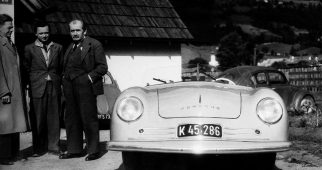Accueil > Documentation (EN) > Porsche – Usines (EN)
PORSCHE
Check Engine is here to help you find your way around the hundreds of models that the German manufacturer Porsche has offered or has offered since 1931.
We also invite you to discover a page of Porsche‘s history, as well as its factories in Stuttgart and Leipzig.
FACTORY
STUTTGART (1931 – 1938) / Germany
Founded in 1931, the Porsche design and construction office, which specialised in the manufacture and development of racing cars, was located at Kronenstrasse 24 in Stuttgart city centre.
ZUFFENHAUSEN (1938 – today) / Germany
The company moves to a new group of buildings in the Zuffenhausen district, 15 minutes north of Stuttgart, in June 1938. It was here that the first series of Volkswagen Beetles was built in 1938 on Hitler’s orders, followed in 1939 by the Type 64, the forerunner of all the Porsche sports cars that later saw the light of day.
Forced to move to Gmund in Austria after the German defeat, Porsche built some 49 examples of the 1st 356 there, before returning to Stuttgart at the end of 1949.
As the Porsche factory at Zuffenhausen was still occupied by the American army at the time, Porsche first rented a production centre at the nearby Reutter factory, before returning to Zuffenhausen, which soon proved too small in view of the 356’s success.


The buildings forming Porsche Plant 2, built in 1950, were completed in 1952. Factory 3 followed in 1960, which also housed the sales and customer service divisions.
Today, the complex comprises 7 divisions: body shop, paint shop, vehicle assembly, trim, engine assembly and dynamometers. Production Porsche models are built alongside racing versions on the same assembly line.
Today, almost 3,000 people work here, producing the 911, Boxster and Cayman, as well as all Porsche engines (except diesel engines, which are currently borrowed from Audi).
On the same site in Zuffenhausen, the Porsche Museum opened its doors in 2009, celebrating its one millionth visitor 2 years later!

WEISSACH (1971 – today) / Germany
This is Porsche’s research and development centre, the place where future models are born (notably the GT2 RS…). They also have their own test track, located 30 minutes from Zuffenhausen, where 3800 people work!

UUSIKAUPUNKI (1997 to 2011) / Finland
Porsche was unable to cope with the success of the Boxster and for almost 15 years subcontracted a large part of the production of the Boxster and Cayman to VALMET Automotive Inc, an independent car manufacturer. By May 2011, it will have produced 227,890 vehicles for Porsche (109,913 Boxster 986s, 59,264 Boxster 987s and 59,413 Caymans). The collaboration will continue until the end of 2011, with Valmet delivering body components for the Boxster and Cayman until September 2011.
From 2012, this subcontracting will be done through a VW factory located in OSNABRUCK in northern Germany.

LEIPZIG (2002 – today) / Germany
In 2002, Porsche built a 2nd production site in eastern Germany to produce the Cayenne (35,000 units/year). The factory was doubled in size in 2007 to produce the Panamera (25,000 units/year). The Carrera GT was also assembled here between 2003 and 2005. It will also be the production site for the future CAJUN (CAyenne JUNior) from 2012. 1,000 employees will produce these 2 models. The plant has its own asphalt and off-road test track.
In 2011, Leipzig does not have its own bodywork, and both the Panamera and Cayenne bodies are subcontracted to VW. The Panamera bodies arrive painted and bare, while the Cayennes arrive pre-assembled (excluding running gear and powertrains). As Porsche worked on the Cayenne, Touareg and Q7 project in Weissach, it subcontracted a large part of its production to VW at the Bratislava plant in Czechoslovakia, and the vehicles were delivered directly by rail to the Leipzig plant.



